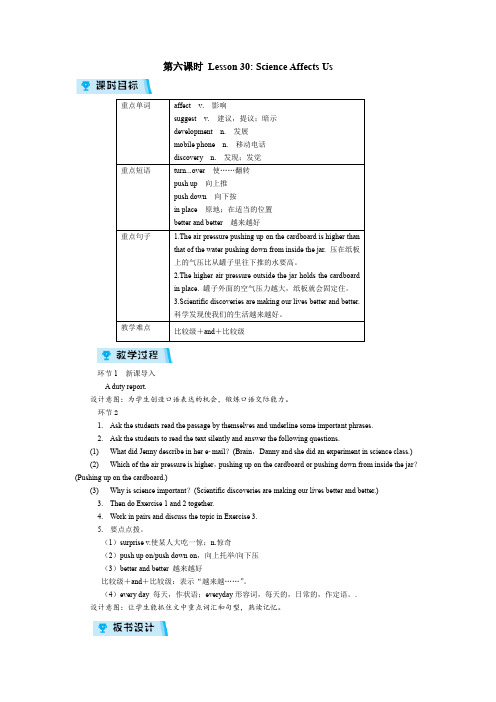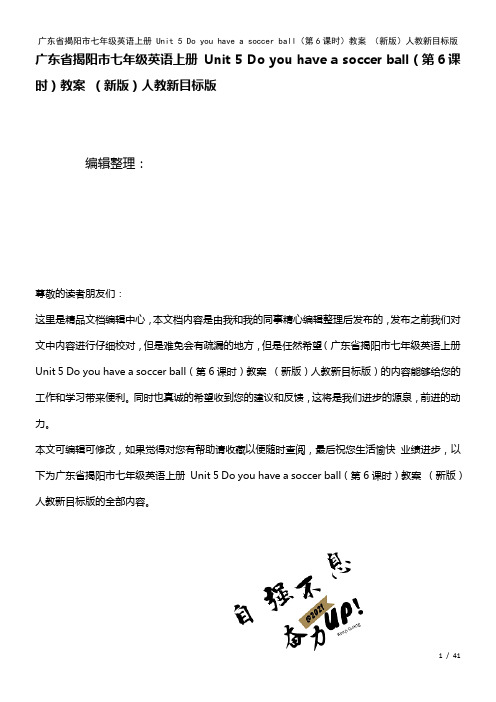Unit5_第6课时教案
- 格式:doc
- 大小:47.50 KB
- 文档页数:4



Unit5 Dinner’s ready第六课时(Read and write Story time)教学目标1. 能够读懂Read and write里的对话。
2. 能在有意义的语境中使用本单元的词汇并完成句子。
3. 能听懂Story time里的内容。
教学重点能够读懂Read and write里的对话。
教学难点能在有意义的语境中使用本单元的词汇并完成句子。
教学准备教师准备餐具图片、录音、课件等。
学生准备四线三格英文本等。
教学过程Step 1: Warm-up1. 师生自由对话,活跃课堂气氛。
2. You say, I do.教师给出上节课所学Let's do的指令,学生听指令,做动作。
Step 2: Presentation1. Teach“Read and tick”.活动: 猜猜晚餐吃什么教师呈现John傍晚在家的图片,并说: Look! John is at home. It's time for dinner. What would he like for dinner ?Can you guess? 学生猜测食物,教师分类板书单词,并补充所有已学的食物类单词。
学生朗读板书内容,并借助图片阅读对话,找到晚餐想吃的食物:beef and noodles,并得知John晚餐使用的餐具: chopsticks。
教师说:Yes, we use chopsticks for noodles. We don't use a knife and fork for noodles.2.Teach“Story time”.教师让学生看图片,呈现故事中猫老板站在餐馆柜台前的图片。
教师问: Who is she?学生答: She is Miss Cat.教师肯定学生的回答: Yes, she is Miss Cat. Look! She has a restaurant. There are many kinds of food. What's in her restaurant? Can you guess? 请学生猜测猫老板的餐馆里有什么食物。

译林版六年级上册第五单元Unit 5 Signs第5课时教案()1. May 21st reads.A. May twenty-oneB. the May twenty-firstC. the twenty-first of May()2. "Keep off the grass“ means we walk on the grass.A. canB. shouldn'tC. mustD. should ()3. Jim and Ben are about Ben's birthday. A. talking B. saying C.speaking()4. The camera isn't in my pocket. It there yesterday. A. be B. was C. is D. were()5. Mr. Green usually his friends when he was young. A. writes B. is writing C. wrote D. write()6. Does the sign'No'?Yes, it does. A. say, fishing B. says, fish C. says, fishing ()7. Why we swim in the river?Can't you see the sign 'No swimmingthere? A. can B. should C. can't D. shouldn't()8. Where were my shoes?A. It's on the desk.B. They are under the desk.C. They were under the desk. Step5 Blackboard design 1. What does this sign mean?2. It means you can't park your car here.3. You can't take your juice into the shop.4. What do these signs mean?5. They mean 'No running 5.授后小记:本课的重难点知识是针对dirty 和messy 的解决方法,教师在教学完书本知识 后,可以给此题是对知识点 的巩固,帮助学生在 不同语境下运用不同 的动词,加强语言运 用。

第六课时Lesson 30: Science Affects Us环节1 新课导入A duty report.设计意图:为学生创造口语表达的机会,锻炼口语交际能力。
环节21.Ask the students read the passage by themselves and underline some important phrases.2.Ask the students to read the text silently and answer the following questions.(1)What did Jenny describe in her email?(Brain,Danny and she did an experiment in science class.)(2)Which of the air pressure is higher,pushing up on the cardboard or pushing down from inside the jar?(Pushing up on the cardboard.)(3)Why is science important?(Scientific discoveries are making our lives better and better.)3.Then do Exercise 1 and 2 together.4.Work in pairs and discuss the topic in Exercise 3.5.要点点拨。
(1)surprise v.使某人大吃一惊;n.惊奇(2)push up on/push down on,向上托举/向下压(3)better and better 越来越好比较级+and+比较级:表示“越来越……”。
(4)every day 每天,作状语;everyday形容词,每天的,日常的,作定语。

广东省揭阳市七年级英语上册Unit 5 Do you have a soccer ball(第6课时)教案(新版)人教新目标版编辑整理:尊敬的读者朋友们:这里是精品文档编辑中心,本文档内容是由我和我的同事精心编辑整理后发布的,发布之前我们对文中内容进行仔细校对,但是难免会有疏漏的地方,但是任然希望(广东省揭阳市七年级英语上册Unit 5 Do you have a soccer ball(第6课时)教案(新版)人教新目标版)的内容能够给您的工作和学习带来便利。
同时也真诚的希望收到您的建议和反馈,这将是我们进步的源泉,前进的动力。
本文可编辑可修改,如果觉得对您有帮助请收藏以便随时查阅,最后祝您生活愉快业绩进步,以下为广东省揭阳市七年级英语上册Unit 5 Do you have a soccer ball(第6课时)教案(新版)人教新目标版的全部内容。
Unit 5 Do you have a soccer ballThe Sixth PeriodSection B 3a—self checkI。
Teaching aims:1。
Review unit 5 and have self check2. Learn to master the Target language:—Do you have …?—Yes, I do. / No, I don't。
—Does she/he have a tennis ball? —Yes, she/he does./ No, she/he doesn’t。
—Do they have a soccer ball?—Yes, they do。
/ No, they don’t。
Let’s play computer games.That sounds interesting/relaxing/boring/difficult.3. Learn to write small passage about sports like the sample in 2b。
Unit 5 What were you doing when the rainstormcame?第一课时Section A (1a2d)【学习目标】1.重点单词:rainstorm,suddenly,alarm,strange2.重点短语:on the street,at the bus stop,go off,take a hot shower,miss the bus,pick up,so many times3.重点句式:What were you doing when the rainstorm came?What was the girl doing at the time of the rainstorm?I called at seven and you didn't pick up.I was in the kitchen helping my mother.I was sleeping at that time.While you were sleeping,I called Jenny and she helped me.【学习重点】1.重点短语和句型2.过去进行时态的用法3.when和while的用法【学习难点】1.过去进行时态的用法2.when和while的用法【自主学习】一、预习课本P3334新单词并背诵,完成下面的汉译英。
1.暴风雨__________ 2.突然__________3.闹钟__________ 4.奇特的__________二、认真预习1a2d找出下列短语和句型。
1.在街上2.在公共汽车站3.洗热水澡4.错过汽车5.接电话6.这么多次7.暴风雨来临的时候你正在做什么?8.我七点打了电话,但是你没有接。
9.我在厨房给我妈妈帮忙。
10.我那时在睡觉。
11.当你睡觉的时候,我给Jenny打了电话,她帮助了我。
【课堂导学】Step 1情景导入The teacher points at a girl in the classroom and asks:Teacher:Where are you?Student 1:I am in the classroom...Teacher:What are you doing?Student 1:I am answering your questions.The teacher writes “What are you doing?”on the blackboard and asks in Chinese:这是什么时态?引导学生回答,复习现在进行时态的意义及结构。
Unit 5 Seasons单元教材分析:本单元的主要学习描述不同季节的气候特征,以及不同季节里人们经常从事的活动。
教师可以先鼓励学生根据自己平时的观察,用已有的语言知识,对当季的气候特征或者当天的天气做简单描述。
在学习目标词汇和新句型后,让学生进行自主描述,体现循序渐进的教学方法。
教师在词汇教学中,可多多利用图片或实物,启发学生联想,使他们更好地掌握关于季节和温度的词汇。
教师可以结合3AUnit6,4AUnit4和4BUnit4的句型和词汇,设计词汇教学活动或拓展活动。
教学目标:1.能听懂、会说、会读、会写句型和日常用语In spring,it is warm.We go boating.2.能听懂、会说、会读、会写单词season, spring, warm, summer, hot, autumn, cool, winter, cold.3.能听懂、会说、会读、会写单词fly, kite, go boating,go swimming, picnic, go climbing, go skating, fine, hey, whose.4.会唱歌曲A sunny day.5.学习字母i在单词中的读音/ai/,能听懂、会说、发音准确。
教学重点:1.在听说读练中,学会单词season, spring, warm, summer, hot, autumn, cool, winter, cold。
2.在听说训练中,学会句型In spring, it iswarm.We go boating.3. 通过听说训练,能正确听读、辨认字母i在单词中的发音/ai/。
教学难点:1.在听说训练中,学会句型In spring, it is warm.We go boating.2. 在听说读练中,学会单词fly, kite, go boating,go swimming, picnic, go climbing, go skating,fine,hey,whose3.通过听说训练,能正确听读、辨认字母i在单词中的发音/ai/课时安排:第1课时:Story time第2课时:Fun time第3课时:Cartoon time第4课时:Sound time & Song time第5课时:Checkout time & 补充习题第6课时:Exercise第1课时(总第课时)上课时间:月日课型:课教学内容:Unit 5 seasons(Story time)教学目标:1. 能听懂、会说、会读、会写season, spring, warm, summer, hot, autumn, cool, winter, cold。
最新人教PEP版小学英语五年级下册 Unit 5 第6课时优质课教学设计一、教学目标1.学习外貌用语,掌握形容外貌的形容词及其用法;2.学习日常礼仪,懂得尊重他人;3.提高语言应用能力。
二、教学内容1. 词汇形容词:tall, short, thin, heavy, strong, fast, slow, clever, kind2. 句型1.What does he/she look like? - He/She istall/short/thin/heavy/strong/fast/slow/clever/kind.2.Thank you./You’re welcome.3. 语法形容词的比较级。
三、教学重难点1.掌握形容外貌的形容词;2.学会运用比较级;3.掌握礼仪用语。
四、教学准备PPT、课件、单词卡片。
五、教学过程1. Warm-up1.Greet students and introduce yourself;2.Ask students to introduce themselves and describe their own appearance.2. Presentation1.Introduce the new vocabulary: tall, short, thin, heavy, strong, fast, slow, clever, kind;2.Pronounce the words and ask students to repeat after the teacher;3.Show pictures of people and ask students to describe their appearance using the new vocabulary.3. Practice1.Ask students to look at the pictures on the screen or the textbook and invite one student to ask the question。